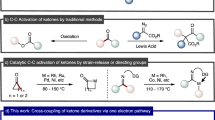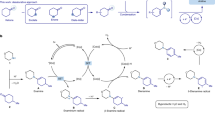Abstract
Redox processes and radical intermediates are found in many biochemical processes, including deoxyribonucleotide synthesis and oxidative DNA damage1. One of the core principles underlying DNA biosynthesis is the radical-mediated elimination of H2O to deoxygenate ribonucleotides, an example of ‘spin-centre shift’2, during which an alcohol C–O bond is cleaved, resulting in a carbon-centred radical intermediate. Although spin-centre shift is a well-understood biochemical process, it is underused by the synthetic organic chemistry community. We wondered whether it would be possible to take advantage of this naturally occurring process to accomplish mild, non-traditional alkylation reactions using alcohols as radical precursors. Because conventional radical-based alkylation methods require the use of stoichiometric oxidants, increased temperatures or peroxides3,4,5,6,7, a mild protocol using simple and abundant alkylating agents would have considerable use in the synthesis of diversely functionalized pharmacophores. Here we describe the development of a dual catalytic alkylation of heteroarenes, using alcohols as mild alkylating reagents. This method represents the first, to our knowledge, broadly applicable use of unactivated alcohols as latent alkylating reagents, achieved via the successful merger of photoredox and hydrogen atom transfer catalysis. The value of this multi-catalytic protocol has been demonstrated through the late-stage functionalization of the medicinal agents, fasudil and milrinone.
This is a preview of subscription content, access via your institution
Access options
Subscribe to this journal
Receive 51 print issues and online access
$199.00 per year
only $3.90 per issue
Buy this article
- Purchase on Springer Link
- Instant access to full article PDF
Prices may be subject to local taxes which are calculated during checkout




Similar content being viewed by others
References
Halliwell, B. & Gutteridge, J. M. C. Free Radicals in Biology and Medicine 4th edn (Oxford Univ. Press, 2007)
Wessig, P. & Muehling, O. Spin-center shift (SCS) – a versatile concept in biological and synthetic chemistry. Eur. J. Org. Chem. 2219–2232 (2007)
Minisci, F., Vismara, E. & Fontana, F. Homolytic alkylation of protonated heteroaromatic bases by alkyl iodides, hydrogen peroxide, and dimethyl sulfoxide. J. Org. Chem. 54, 5224–5227 (1989)
Molander, G. A., Colombel, V. & Braz, V. A. Direct alkylation of heteroaryls using potassium alkyl- and alkoxymethyltrifluoroborates. Org. Lett. 13, 1852–1855 (2011)
Ji, Y. et al. Innate C–H trifluoromethylation of heterocycles. Proc. Natl Acad. Sci. USA 108, 14411–14415 (2011)
Antonchick, A. P. & Burgmann, L. Direct selective oxidative cross-coupling of simple alkanes with heteroarenes. Angew. Chem. Int. Edn Engl. 52, 3267–3271 (2013)
DiRocco, D. A. et al. Late-stage functionalization of biologically active heterocycles through photoredox catalysis. Angew. Chem. Int. Edn Engl. 53, 4802–4806 (2014)
Eklund, H., Uhlin, U., Färnegårdh, M., Logan, D. T. & Nordlund, P. Structure and function of the radical enzyme ribonucleotide reductase. Prog. Biophys. Mol. Biol. 77, 177–268 (2001)
Schönherr, H. & Cernak, T. Profound methyl effects in drug discovery and a call for new C–H methylation reactions. Angew. Chem. Int. Edn Engl. 52, 12256–12267 (2013)
Minisci, F., Bernardi, R., Bertini, F., Galli, R. & Perchinunno, M. Nucleophilic character of alkyl radicals–VI: A new convenient selective alkylation of heteroaromatic bases. Tetrahedron 27, 3575–3579 (1971)
Duncton, M. A. J. Minisci reactions: versatile CH-functionalizations for medicinal chemists. Med. Chem. Commun. 2, 1135–1161 (2011)
Narayanam, J. M. R. & Stephenson, C. R. J. Visible light photoredox catalysis: applications in organic synthesis. Chem. Soc. Rev. 40, 102–113 (2011)
Prier, C. K., Rankic, D. A. & MacMillan, D. W. C. Visible light photoredox catalysis with transition metal complexes: applications in organic synthesis. Chem. Rev. 113, 5322–5363 (2013)
Schultz, D. M. & Yoon, T. P. Solar synthesis: prospects in visible light photocatalysis. Science 343, 1239176 (2014)
Qvortrup, K., Rankic, D. A. & MacMillan, D. W. C. A general strategy for organocatalytic activation of C–H bonds via photoredox catalysis: direct arylation of benzylic ethers. J. Am. Chem. Soc. 136, 626–629 (2014)
Hager, D. & MacMillan, D. W. C. Activation of C–H bonds via the merger of photoredox and organocatalysis: a coupling of benzylic ethers with Schiff bases. J. Am. Chem. Soc. 136, 16986–16989 (2014)
Cuthbertson, J. D. & MacMillan, D. W. C. The direct arylation of allylic sp3 C–H bonds via organic and photoredox catalysis. Nature 519, 74–77 (2015)
Jin, J. & MacMillan, D. W. C. Direct α-arylation of ethers through the combination of photoredox-mediated C–H functionalization and the Minisci reaction. Angew. Chem. Int. Edn Engl. 54, 1565–1569 (2015)
Ochiai, M. & Morita, K. A novel photo-induced methylation of pyrimidines and condensed pyrimidine compounds. Tetrahedr. Lett. 8, 2349–2351 (1967)
Stermitz, F. R., Wei, C. C. & Huang, W. H. Imine photoalkylations: quinolone and isoquinoline. Chem. Commun. (Lond.) 1968, 482–483 (1968)
Sugimori, A. et al. Radiation-induced alkylation of quinoline derivatives with alcohol. Bull. Chem. Soc. Jpn. 59, 3905–3909 (1986)
Slinker, J. D. et al. Efficient yellow electroluminescence from a single layer of a cyclometalated iridium complex. J. Am. Chem. Soc. 126, 2763–2767 (2004)
Shaidarova, L. G., Ziganshina, S. A. & Budnikov, G. K. Electrocatalytic oxidation of cysteine and cystine at a carbon-paste electrode modified with ruthenium(IV) oxide. J. Anal. Chem. 58, 577–582 (2003)
Escoubet, S. et al. Thiyl radical mediated racemization of nonactivated aliphatic amines. J. Org. Chem. 71, 7288–7292 (2006)
Berkowitz, J., Ellison, G. B. & Gutman, D. Three methods to measure RH bond energies. J. Phys. Chem. 98, 2744–2765 (1994)
Roberts, B. P. Polarity-reversal catalysis of hydrogen-atom abstraction reactions: concepts and applications in organic chemistry. Chem. Soc. Rev. 28, 25–35 (1999)
Cai, Y. & Roberts, B. P. Radical-chain racemization of tetrahydrofurfuryl acetate under conditions of polarity-reversal catalysis: possible implications for the radical-induced strand cleavage of DNA. Chem. Commun. (Camb.) 1998, 1145–1146 (1998)
McNally, A., Prier, C. K. & MacMillan, D. W. C. Discovery of an α-amino C–H arylation reaction using the strategy of accelerated serendipity. Science 334, 1114–1117 (2011)
Acknowledgements
Financial support was provided by NIHGMS (R01 GM103558-03), and gifts from Merck and Amgen. J.J. thanks J. A. Terrett for assistance in preparing this manuscript.
Author information
Authors and Affiliations
Contributions
J.J. performed and analysed experiments. J.J. and D.W.C.M. designed experiments to develop this reaction and probe its utility, and also prepared this manuscript.
Corresponding author
Ethics declarations
Competing interests
The authors declare no competing financial interests.
Supplementary information
Supplementary Information
This file contains Supplementary Text and Data 1-5, Supplementary Figures 1-13 and NMR Spectras (see Contents for details). (PDF 29916 kb)
Rights and permissions
About this article
Cite this article
Jin, J., MacMillan, D. Alcohols as alkylating agents in heteroarene C–H functionalization. Nature 525, 87–90 (2015). https://doi.org/10.1038/nature14885
Received:
Accepted:
Published:
Issue Date:
DOI: https://doi.org/10.1038/nature14885
This article is cited by
-
Recovery of homogeneous photocatalysts by covalent organic framework membranes
Nature Communications (2023)
-
The interplay of polar effects in controlling the selectivity of radical reactions
Nature Synthesis (2022)
-
Recent Advances in the Use of Dimethyl Sulfoxide as a Synthon in Organic Chemistry
Topics in Current Chemistry (2022)
-
Selective deoxygenative alkylation of alcohols via photocatalytic domino radical fragmentations
Nature Communications (2021)
-
Generation of non-stabilized alkyl radicals from thianthrenium salts for C–B and C–C bond formation
Nature Communications (2021)
Comments
By submitting a comment you agree to abide by our Terms and Community Guidelines. If you find something abusive or that does not comply with our terms or guidelines please flag it as inappropriate.



